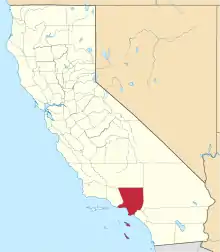Bellflower, California
Bellflower is a city located in southeast Los Angeles County, California, in the Los Angeles metropolitan area. It was founded in 1906 and incorporated on September 3, 1957. As of the 2010 census, the city had a total population of 76,616, up from 72,878 at the 2000 census. This made it the 25th most densely populated city in the United States, of cities over 50,000 residents (and the 8th most densely populated city in California).[8]
Bellflower, California | |
|---|---|
City | |
| City of Bellflower | |
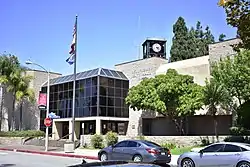 | |
 Flag | |
| Nickname(s): "The Friendly City" | |
| Motto(s): "Growing Together" | |
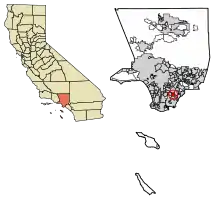 Location of Bellflower in Los Angeles County, California. | |
 Bellflower, California Location in the United States | |
| Coordinates: 33°53′17″N 118°7′39″W | |
| Country | |
| State | |
| County | |
| Founded | 1906[1] |
| Incorporated | September 3, 1957[2] |
| Named for | Yellow bellflower apple |
| Government | |
| • City council[3] | Juan Garza (mayor) Sonny Santa Ines Ray Dunton Dan Koops Ray Hamada |
| • City Manager | Jeffrey L. Stewart |
| Area | |
| • Total | 6.17 sq mi (15.98 km2) |
| • Land | 6.12 sq mi (15.85 km2) |
| • Water | 0.05 sq mi (0.14 km2) 0.86% |
| Elevation | 71 ft (22 m) |
| Population | |
| • Total | 76,616 |
| • Estimate (2019)[7] | 76,435 |
| • Density | 12,493.46/sq mi (4,823.76/km2) |
| Time zone | UTC-8 (Pacific) |
| • Summer (DST) | UTC-7 (PDT) |
| ZIP codes | 90706, 90707 |
| Area code | 562 |
| FIPS code | 06-04982 |
| GNIS feature IDs | 1652671, 2409822 |
| Website | www |
The site was formerly rich farmland watered by artesian wells and floodwaters of the now-contained San Gabriel River. In 1906, F.E. Woodruff, a local real estate investor,[9] founded the first municipality on the site, which was named Somerset in 1909 when a post office was established there.[10] However, the Post Office Department rejected the name to prevent confusion with Somerset, Colorado.[10] The present name is derived from the bellflower apple, which was grown in local orchards during the early 1900s.
Originally settled by small communities of dairy farmers of Dutch, Japanese, and Portuguese descent, Bellflower and neighboring Paramount served first as the apple and later the milk production centers for Southern California, until soaring post-World War II property values forced most of the farmers to move several miles east to the Dairy Valley/Dairyland/Dairy City area (now the cities of Cerritos, La Palma, and Cypress). These farms were in turn converted into large housing subdivisions for Los Angeles's growing population that worked in the region's skilled industrial and service sectors.
After Bellflower was incorporated in 1957, its gradual metamorphosis from agricultural center to residential suburb continued. From the 1950s through the late 1960s, Bellflower Boulevard, the city's main thoroughfare, was a thriving commercial strip for shopping. Numerous retail and franchise restaurant firms began on this street, which also featured middle- and high-end boutiques, arts and crafts shops, and other small shopkeeps alongside larger department stores and banks. It is a sister city with Los Mochis, Sinaloa, Mexico.[11]
Geography
Bellflower is located at 33°53′17″N 118°07′39″W.[12]
According to the United States Census Bureau, the city has a total area of 6.2 square miles (16 km2). 6.1 square miles (16 km2) of it is land and 0.1 square miles (0.26 km2) of it (0.86%) is water.
Bellflower is bordered by Downey on the north and northwest, Norwalk and Cerritos on the east, Lakewood on the south, Long Beach on the southwest, and Paramount on the west. Bellflower is part of Southeast Los Angeles County and the "Gateway Cities Council of Governments" (GCOG).
Demographics
| Historical population | |||
|---|---|---|---|
| Census | Pop. | %± | |
| 1960 | 45,909 | — | |
| 1970 | 52,334 | 14.0% | |
| 1980 | 53,441 | 2.1% | |
| 1990 | 61,815 | 15.7% | |
| 2000 | 72,878 | 17.9% | |
| 2010 | 76,616 | 5.1% | |
| 2019 (est.) | 76,435 | [7] | −0.2% |
| U.S. Decennial Census[13] | |||
2010
At the 2010 census Bellflower had a population of 76,616. The population density was 12,416.7 people per square mile (4,794.1/km2). The racial makeup of Bellflower was 32,337 (42.2%) White (19.5% Non-Hispanic White),[14] 10,760 (14.0%) African American, 731 (1.0%) Native American, 8,865 (11.6%) Asian, 615 (0.8%) Pacific Islander, 19,732 (25.8%) from other races, and 3,576 (4.7%) from two or more races. Hispanic or Latino of any race were 40,085 persons (52.3%).[15]
The census reported that 75,877 people (99.0% of the population) lived in households, 399 (0.5%) lived in non-institutionalized group quarters, and 340 (0.4%) were institutionalized.
There were 23,651 households, 11,029 (46.6%) had children under the age of 18 living in them, 10,992 (46.5%) were opposite-sex married couples living together, 4,812 (20.3%) had a female householder with no husband present, 1,965 (8.3%) had a male householder with no wife present. There were 1,666 (7.0%) unmarried opposite-sex partnerships, and 170 (0.7%) same-sex married couples or partnerships. 4,618 households (19.5%) were one person and 1,540 (6.5%) had someone living alone who was 65 or older. The average household size was 3.21. There were 17,769 families (75.1% of households); the average family size was 3.67.
The age distribution was 21,749 people (28.4%) under the age of 18, 8,493 people (11.1%) aged 18 to 24, 22,418 people (29.3%) aged 25 to 44, 17,339 people (22.6%) aged 45 to 64, and 6,617 people (8.6%) who were 65 or older. The median age was 31.9 years. For every 100 females, there were 94.4 males. For every 100 females age 18 and over, there were 90.6 males.
There were 24,897 housing units at an average density of 4,034.9 per square mile, of the occupied units 9,459 (40.0%) were owner-occupied and 14,192 (60.0%) were rented. The homeowner vacancy rate was 1.7%; the rental vacancy rate was 5.1%. 31,897 people (41.6% of the population) lived in owner-occupied housing units and 43,980 people (57.4%) lived in rental housing units.
According to the 2010 United States Census, Bellflower had a median household income of $49,637, with 17.1% of the population living below the federal poverty line.[14]
2000
At the 2000 census there were 72,878 people in 23,367 households, including 17,128 families, in the city. The population density was 11,999.5 inhabitants per square mile (4,635.6/km2). There were 24,247 housing units at an average density of 3,992.3 per square mile (1,542.3/km2). The racial makeup of the city was 22.37% White American, 33.09% Black or African American, 0.92% Native American, 9.69% Asian, 0.70% Pacific Islander, 24.38% from other races, and 5.13% from two or more races. 43.23% of the population were Hispanic or Latino of any race.[16] Of the 23,367 households 43.7% had children under the age of 18 living with them, 47.0% were married couples living together, 19.0% had a female householder with no husband present, and 26.7% were non-families. 21.1% of households were one person and 7.5% were one person aged 65 or older. The average household size was 3.09 and the average family size was 3.59.
The age distribution was 31.9% under the age of 18, 10.3% from 18 to 24, 32.0% from 25 to 44, 17.4% from 45 to 64, and 8.4% 65 or older. The median age was 30 years. For every 100 females, there were 95.1 males. For every 100 females age 18 and over, there were 90.6 males.
The median household income was $39,362 and the median family income was $42,822. Males had a median income of $32,658 versus $28,012 for females. The per capita income for the city was $15,982 and was below the "poverty rate". About 12.8% of per capita family households and 15.8% of the population were below the poverty line, including 20.7% of those under age 18 and 10.0% of those age 65 or over.
Economy
Top employers
According to the city's 2011 Comprehensive Annual Financial Report,[17] the top employers in the city are:
| # | Employer | # of Employees |
|---|---|---|
| 1 | Bellflower Medical Center | 530 |
| 2 | Kaiser Permanente | 271 |
| 3 | Time Warner Cable | 186 |
| 4 | Hollywood Sports | 167 |
| 5 | City of Bellflower | 163 |
| 6 | K-Mart | 0 |
| 7 | Bel Tooren Villa Convalescent Hospital | 120 |
| 8 | Woodruff Convalescent Center | 117 |
| 9 | Bellflower Dental Group | 106 |
| 10 | Stater Bros. | 0 |
Government
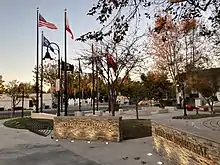
In the California State Legislature, Bellflower is in the 32nd Senate District, represented by Democrat Bob Archuleta. In the California State Assembly, it is in the 58th Assembly District, represented by Democrat Cristina Garcia.[18]
In the United States House of Representatives, Bellflower is split between 38th and 40th congressional districts,[19] which are represented by Linda Sánchez (D–Whittier) and Lucille Roybal-Allard (D–Los Angeles), respectively.[20]
Infrastructure
Fire protection in Bellflower is provided by the Los Angeles County Fire Department from stations 23 and 98. Ambulance transport is provided by Care Ambulance Service.
The Los Angeles County Sheriff's Department operates the Lakewood Station in Lakewood, serving Bellflower.[21] In addition the sheriff's department operates the Bellflower Substation in Bellflower.[22]
The United States Postal Service Bellflower Post Office is located at 9835 Flower Street.[23]
Transportation
The Artesia Freeway (State Route 91) passes east–west through the southern portion of Bellflower, the San Gabriel River Freeway (Interstate 605) runs north–south just east of the city, and the Century Freeway (Interstate 105) runs east–west just north of the city.
Bellflower is served by bus service from Los Angeles County Metropolitan Transportation Authority (MTA) and Long Beach Transit. The city also operates Bellflower Bus, a fixed-route local bus.
Education
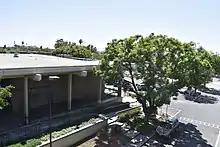
Most of Bellflower is within the Bellflower Unified School District. St. John Bosco High School, and Valley Christian Elementary both privately run, are also in Bellflower. The Clifton M. Brakensiek Library is a branch of the County of Los Angeles Public Library.[24]
Notable people
- Chris Carter, television and film producer, director and writer, creator of The X-Files
- Ronnie Correy, motorcycle speedway rider
- Kirk Fletcher, electric blues guitarist, singer and songwriter, was born in Bellflower in 1975.[25]
- Nomar Garciaparra, Major League Baseball shortstop, 6-time All-Star, 2-time batting champion, TV commentator; attended St. John Bosco High School[26]
- A.J. Gass, former Canadian Football League player
- Anthony Gose, Major League Baseball outfielder, currently in Detroit Tigers organization
- Shauna Grant (1963–1984), screen name of pornographic actress Colleen Applegate, was born here[27]
- Trevor Hoffman, Major League Baseball relief pitcher, 7-time All-Star, born in Bellflower[28]
- Jeff Kent, Major League Baseball second baseman, 5-time All-Star, 2000 National League MVP; born in Bellflower[29]
- Vanessa Lam, figure skater, 2012 Junior Grand Prix finalist
- Adam Liberatore, Major League Baseball relief pitcher with Los Angeles Dodgers
- Evan Longoria, Major League Baseball third baseman, 3-time All-Star[30] graduated from St. John Bosco High School in 2003
- Kimberly McCullough, actress, General Hospital
- Wendi McLendon-Covey, actress, appeared in film Bridesmaids, was born in Bellflower
- Valentino Pascucci, professional baseball player, 2004–11
- Jerry Quarry, heavyweight boxer, former #1 ranked contender
- Carlos Quentin, Major League Baseball outfielder, 2-time All-Star[31]
- Sergio Santos, Major League Baseball relief pitcher 2010-15
- Brandon Sermons, professional football player
- Anneliese van der Pol, actress; attended Ramona Elementary School and Bellflower High School
- Derrick Williams, professional basketball player with five NBA teams, 2011 Pac-10 Player of the Year[32]
- Ron Yary, professional football player in College and Pro Football Hall of Fame; graduated Bellflower High School in 1964
- James Harden, professional basketball player in NBA and Former Regular Season MVP; born in Bellflower
References
- "City of Bellflower - City History". Bellflower.org. Retrieved October 4, 2018.
- "California Cities by Incorporation Date". California Association of Local Agency Formation Commissions. Archived from the original (Word) on November 3, 2014. Retrieved August 25, 2014.
- "City Council". City of Bellflower. Retrieved April 26, 2017.
- "2019 U.S. Gazetteer Files". United States Census Bureau. Retrieved July 1, 2020.
- "Bellflower". Geographic Names Information System. United States Geological Survey. Retrieved October 11, 2014.
- "Bellflower (town) QuickFacts". United States Census Bureau. Archived from the original on February 15, 2015. Retrieved February 11, 2015.
- "Population and Housing Unit Estimates". United States Census Bureau. May 24, 2020. Retrieved May 27, 2020.
- "Decennial Census by Decades". Census.gov. Retrieved February 18, 2019.
- ""Mr. F.E. Woodruff of the Active and Reliable Real Estate Firm of Peet & Woodruff Will Live in Westmoreland Tract"". Los Angeles Herald, Vol. XXXI, No. 42. p. 8. November 12, 1903. Archived from the original
|archive-url=requires|url=(help) on|archive-url=requires|archive-date=(help).|access-date=requires|url=(help)CS1 maint: location (link) - Gudde, Erwin G. (1998). California Place Names: The Origin and Etymology of Current Geographical Names. University of California Press. p. 31. ISBN 978-0-520-26619-3.
- "Fundraiser for Bellflower/Los Mochis Sister City Project". Portal.clubrunner.ca.
- "US Gazetteer files: 2010, 2000, and 1990". United States Census Bureau. February 12, 2011. Retrieved April 23, 2011.
- "Census of Population and Housing". Census.gov. Retrieved June 4, 2015.
- "Census data". quickfacts.census.gov. Archived from the original on February 15, 2015.
- "2010 Census Interactive Population Search: CA - Bellflower city". U.S. Census Bureau. Archived from the original on February 3, 2016. Retrieved July 12, 2014.
- "U.S. Census website". United States Census Bureau. Retrieved 2008-01-31.
- "City of Bellflower CAFR" (PDF). Bellflower.org. Archived from the original (PDF) on August 28, 2012. Retrieved August 17, 2012.
- "Statewide Database". UC Regents. Archived from the original on February 1, 2015. Retrieved December 16, 2014.
- "Communities of Interest - City". California Citizens Redistricting Commission. Archived from the original on September 30, 2013. Retrieved September 24, 2014.
- "California's 40th Congressional District - Representatives & District Map". Civic Impulse, LLC. Retrieved September 25, 2014.
- "Lakewood Station Archived December 30, 2009, at the Wayback Machine." Los Angeles County Sheriff's Department. Retrieved on January 21, 2010.
- "Bellflower Sub Station Archived January 14, 2010, at the Wayback Machine." Los Angeles County Sheriff's Department. Retrieved on January 21, 2010.
- "Post Office Location - BELLFLOWER." United States Postal Service. Retrieved on December 6, 2008.
- "Clifton M. Brakensiek Library." County of Los Angeles Public Library. Retrieved on December 6, 2008.
- King, David W. (March 16, 2010). "Kirk Fletcher Releases "My Turn" on Delta Groove Records". Crossharpchronicles.wordpress.com. Retrieved February 19, 2019.
- "Nomar Garciaparra Stats". Baseball Almanac. Retrieved November 18, 2012.
- "Death of a Porn Queen". Frontline. June 8, 1987.
- "Trevor Hoffman Stats". Baseball Almanac. Retrieved November 18, 2012.
- "Jeff Kent Stats". Baseball Almanac. Retrieved November 18, 2012.
- "Evan Longoria Stats". Baseball Almanac. Retrieved November 18, 2012.
- "Carlos Quentin Stats". Baseball Almanac. Retrieved November 18, 2012.
- "Derrick Williams". Basketball-Reference.com. Retrieved November 18, 2012.
External links
| Wikivoyage has a travel guide for Bellflower. |
| Wikimedia Commons has media related to Bellflower, California. |
